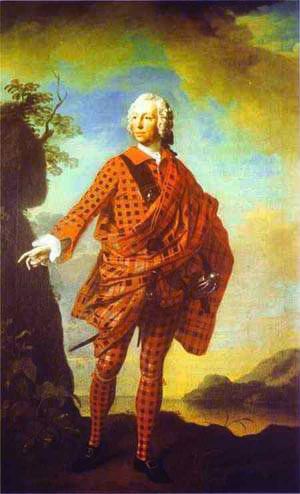Role Politician | Name Norman MacLeod Predecessor John MacLeod of MacLeod | |
 | ||
Born July 29, 1705 ( 1705-07-29 ) Resting place in the kirkyard of St Andrew's Cathedral Successor Norman MacLeod (grandson) Partner(s) 1. Janet Macdonald;2. Ann Martin Children numerous legitimate children; two illegitimate sons Parent(s) Norman MacLeod (father); Anne Fraser (mother) Died 1772, St Andrews, United Kingdom | ||
Norman MacLeod (Scottish Gaelic: Tormod MacLeoid) (1705 – 1772), also known in his own time and within clan tradition as The Wicked Man (Scottish Gaelic: An Droch Dhuine), was an 18th-century politician, and a clan chief of Clan MacLeod. In the 20th century, one chief of Clan MacLeod attempted to have his nickname changed from The Wicked Man, to The Red Man. Today he is regarded as the 22nd Chief of Clan MacLeod.
Contents
Background
Norman MacLeod was the younger son of Norman MacLeod, chief of Clan MacLeod. The elder Norman MacLeod died in 1706, leaving two young sons. The elder son, John, died in infancy in 1707. MacLeod was the Member of Parliament for Inverness-shire during the years 1741-1754. He matriculated arms, and supporters, at Lyon Office, on 12 January 1753. He supported the Government cause in the Jacobite Rising, and was an absentee chief as he seldom lived at his ancestors' traditional seat of Dunvegan Castle.
Jacobite Rising
Norman MacLeod, and his clan, supported the Government during the 1745 Jacobite Rising. Originally MacLeod had pledged his support for the cause, but as soon as Charles Edward Stuart reached Scotland, he is known to have been working against the Jacobite cause. He raised several independent companies for the Government in 1745. In December, MacLeod was ordered to march his troops and engage Lord Lewis Gordon. MacLeod left Inverness on 10 December, with about 700 men. On the night of 23 December he was defeated by a superior force commanded by Gordon at the Battle of Inverurie. About 70 of MacLeod's men were killed, wounded, or captured.
MacLeod, and his clan, did not take part in the Battle of Culloden, instead they and the Macdonalds of Sleat remained on Skye. On 22 April, following the battle, William, Duke of Cumberland ordered John Campbell, 4th Earl of Loudoun, to march all his men into the Highlands and devastate the lands of the men who supported the rebellion. Loudon crossed into the mainland with about 500 of his men; he was followed by Macdonald of Sleat, and MacLeod, who together had about 1,200 men between them. Several days later the combined force laid waste to the lands of Grant of Glenmoriston. MacLeod's men also raided the nearby island of Raasay, in the aftermath of the Jacobite failure. The island was the home of the MacLeods of Raasay, who had supported the Jacobite cause, and who had been present at Culloden. MacLeod's men killed 280 cows, 700 sheep, and 20 horses; they destroyed 32 boats, and razed 300 houses.
Nickname
Norman MacLeod was known in his own time by the nickname "The Wicked Man" (Scottish Gaelic: An Droch Dhuine). This may be partly because, during his minority he went through £60,000 and left his estate in £50,000 in debt. In consequence of this debt, the ancestral clan lands of Harris and Glenelg were lost. Another reason for the name is from his part in the Lady Grange affair, and the ill treatment to his first wife. In the 20th century, Dame Flora MacLeod of MacLeod, chief of Clan MacLeod, tried to have his unflattering nickname changed to "The Red Man", because of the colour of the tartan he wears in the portrait painted by Allan Ramsay (pictured).
Family
Norman MacLeod's first marriage was to Janet, daughter of Sir Donald Macdonald of Sleat, 4th Baronet, in December 1724. MacLeod had his wife live with her mother-in-law and several sisters-in-law at Castle Leod. By 1733, the couple were separated, and remained apart from one another for 7 years. In 1740, Duncan Forbes of Culloden was able to negotiate a reconciliation between the pair, and she then lived with Norman until her death in 1743. According to tradition, Norman brought about Janet's death by locking her in the dungeon of Dunvegan Castle, and leaving her to starve there. Through this marriage, the couple had one son, and two daughters: John, Emilia, and Ann. Five years after Janet's death, MacLeod married Ann, daughter of William Martin of Inchfure. Ann died in 1802. The couple had three daughters: Elizabeth, Ann, and Mary. MacLeod also had two illegitimate sons, Alexander, and Norman.
Death
Norman MacLeod died on 21 July 1772, and was buried in the kirkyard of St Andrew's Cathedral, in St Andrews. The grave lies against the north boundary wall.
He was succeeded by his grandson, Norman MacLeod.
